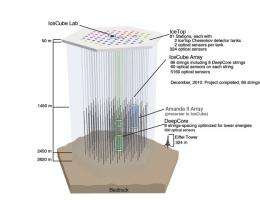April 15, 2011 report
IceCube researchers come up empty on first neutrino test

(PhysOrg.com) -- Physicist Nathan Whitehorn and a team of researchers with the IceCube collaboration have failed to come up with evidence to prove that neutrinos come from, or are caused by, gamma ray bursts, (cosmic explosions) after a year of study.
Neutrinos are neutral particles that travel through space and pass through any object (such as the Earth) in their path. They are able to do so because they have an avoidance property which for the most part keeps them from running into the atoms that make up matter.
The IceCube station was built near the South Pole specifically to capture evidence of the existence of high intensity neutrinos after they’ve passed through the Earth. Many scientists have wondered if they are the result of gamma ray bursts, as some theories predict, but have until now, been unable to test those theories. The IceCube was built to house 5,160 sensitive photon detectors that are able to capture the minute traces of blue light that appear when a neutrino does actually crash head-on into an atom (a very rare occurrence) spraying surrounding ice or water with atomic particles. The idea has been that if such a station were to be built that could capture enough of these collisions before, during and after a gamma ray burst, then it would be possible to see if there was a spike, which would lend credence to the theory that the neutrinos do in fact come from such bursts.
Unfortunately, at least so far, things have not worked out that way. During the period of April 5, 2008, through May 20, 2009, nearly 117 gamma ray bursts were detected, but not once did the researchers see any sort of spike, which has led Whitehorn to concede that the amount of neutrino’s that come from gamma rays, if they do at all, is likely smaller than has been theorized.
Granted, the statistics published in Whitethorn’s paper in Physical Review Letters, come from a time period where the station was still being built and thus didn’t have enough sensors to gather as much evidence as needed, but the worry is if after further research (at least two more years), there is still no conclusive evidence, researchers such as Whitehorn, will be left with little more than some very serious head-scratching questions for which they, nor anyone else, will likely have any answers.
More information: Limits on Neutrino Emission from Gamma-Ray Bursts with the 40 String IceCube Detector, Phys. Rev. Lett. 106, 141101 (2011) DOI:10.1103/PhysRevLett.106.141101
© 2010 PhysOrg.com

















